News, Blog and Media Realeases
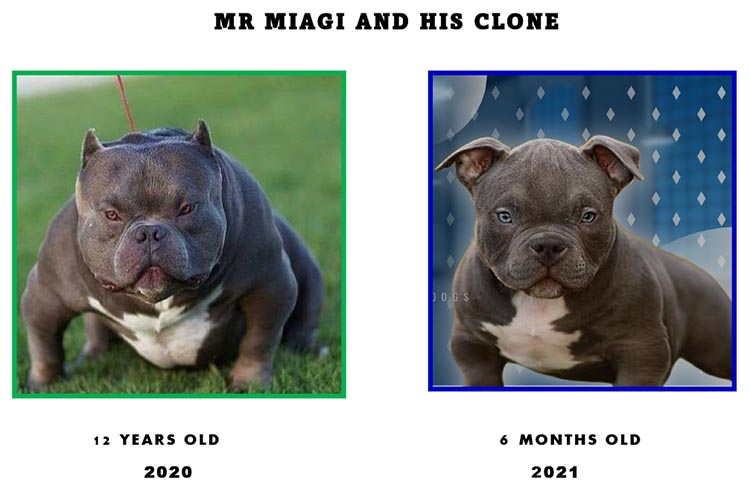
Click Here to view YouTube video of cloned dog Mr. Miagi
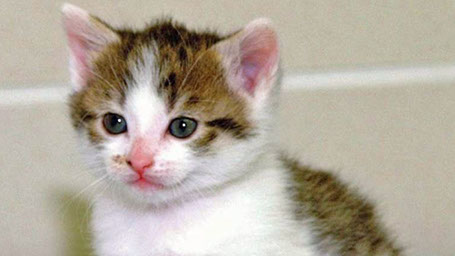 World’s First Cloned Cat ‘CC’ Lived ‘Long, Normal, Happy Life’ Before Her Death - March 4, 2020
World’s First Cloned Cat ‘CC’ Lived ‘Long, Normal, Happy Life’ Before Her Death - March 4, 2020
COLLEGE STATION, Texas (CBSDFW.COM) – The world’s first cloned cat named “Copy Cat” or “CC” for short, has passed away at the age of 18 after veterinarians diagnosed her with kidney failure.
She was born Dec. 22, 2001, and was adopted by Dr. Duane Kraemer, a senior professor in the college’s Reproduction Sciences Laboratory, and his wife, Shirley, six months after her birth.
“We in the CVM are saddened by the passing of CC. As the first cloned cat, CC advanced science by helping all in the scientific community understand that cloning can be effective in producing a healthy animal,” said Dr. Eleanor M. Green, the Carl B. King dean of veterinary medicine at Texas A&M.
“While she lived a long, normal, and happy life, CC was extraordinary in what she represented to the Kraemers, the CVM, and science as a whole,” Green said. “The entire CVM community mourns her loss, as all at Texas A&M cared deeply about her as a member of the Aggie family, and especially for the Kraemers, for whom CC was a beloved pet for 18 years.”
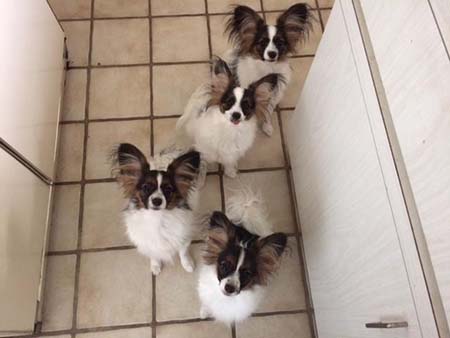 CHARLOT’S CLONES
CHARLOT’S CLONES
One year after receiving Charlot's four clones their owner offers these captivating observations:
“Physically, all four dogs are stronger and healthier than Charlot. Their knees feel pretty solid whereas Charlot’s were rubbery. Each has a different black spot on the white body. Faces are more symmetrically marked than Charlot’s face. All like Charlot are hair machines!
All four are lap dogs, they like nothing better. Each is affectionate. They couldn’t be nicer in that regard. Now, as they are reaching maturity, we see intelligent understanding in their eyes. They listen to speech. Very smart and comprehend a lot. Just like the donor Charlot.
Neighbors used to call Charlot and his brother "the opera singers" because they'd howl together occasionally. Now, all four dogs briefly howl together at least once or twice a day.
All four dogs have aspects of Charlot’s personality, but different aspects and not in the same combination. I think it’s true that clones are twins look-alike individuals having their own souls and personalities.
These dogs are smart and lovable. I love the cloned dogs, they’re my children. Thank you for making these miracles happen.”
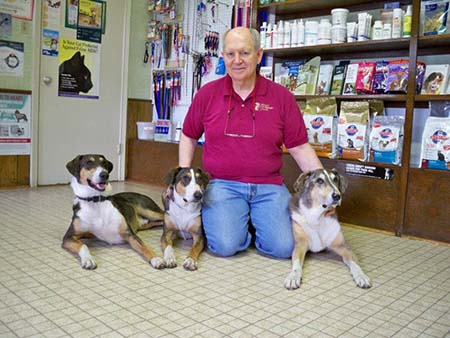 KEN AND HENRY CELEBRATE THEIR 10TH BIRTHDAY
KEN AND HENRY CELEBRATE THEIR 10TH BIRTHDAY
Melvin was the best dog that Dr. Phillip and Paula Dupont ever owned. When Melvin, a mixture of Catahoula and Doberman, turned nine and began to age in 2012, the Duponts decided to preserve his genetics.
Dr. Dupont biopsied two small pieces of Melvin’s skin and sent them to PerPETuate’s laboratory. PerPETuate successfully cultured and then cryopreserved more than three million viable Melvin cells.
Phillip and Paula wanted to use these cells to clone Melvin however they had two concerns. First, the cost to clone a dog was $70,000! Second, only one biotech company was able to clone dogs, the Sooam Biotech Research Foundation in South Korea.
The Duponts justified the cost by the fact that Melvin was an exceptional dog. He greeted visitors to the Dupont veterinary clinic with barking hellos and he had an uncanny ability to understand English. Most important Melvin provided Paula and Phillip with great pleasure. Besides, they reasoned $70,000 was less than the cost of a new Land Cruiser!
Next, the Duponts visited Sooam in South Korea. Being impressed by the biotech staff, laboratory and facilities and by how well the dogs were treated, they contracted Sooam to clone Melvin. In mid-2012 PerPETuate shipped some of Melvin’s cultured cells to South Korea. Sooam used these cells to produce two clones of Melvin—Ken and Henry.
In spring of 2013, Ken and Henry joined Paula, Phillip and Melvin in Louisiana. For the next two years, Melvin was a role model for his clones. When Melvin did pass away having two identical replicas helped ease the couple’s grief. The Duponts say that Ken and Henry are more like Melvin every day. “Their personalities are identical,” says Paula.
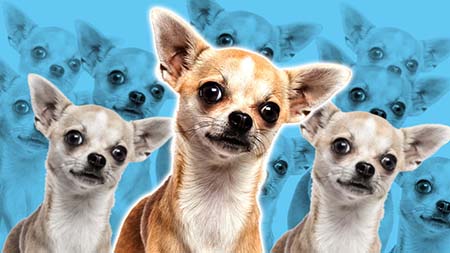 These pampered pooches are popular choices for cloning
These pampered pooches are popular choices for cloning
Chihuahuas are finally getting the respect they deserve.
They may not be the most popular dog breed in America, but they have something else to bark about.
The pint-sized pets lead the pack when it comes to the breeds most commonly selected for cloning, said Ron Gillespie, founder of PerPETuate, the aptly-titled Hawaii-based service that preserves dogs’ genetic material so they can be cloned.
Though there’s no hard data on dog cloning, Gillespie has noticed some patterns in his 20 years in the canine copying business.
Market Watch Article. Click Here for full story.
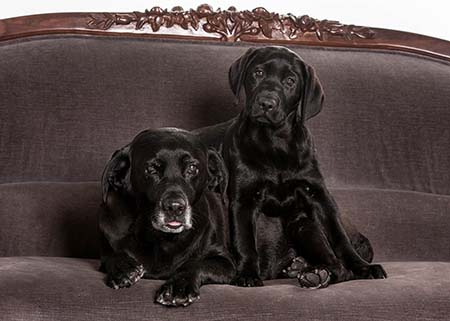 PERPETUATE'S FIRST 2018 CLONE:
PERPETUATE'S FIRST 2018 CLONE:
GUNNI, PerPETuate’s first 2018 clone, was released to her owner Mrs. Monni Must on Jan 5th by ViaGen. Gunni and Monni immediately bonded. Monni said Gunni has the same social personality as her donor—Billy Bean who is still living. They both love people and are fearless. On the flight home the whole airport took photos of Gunni and the Delta attendants passed her around during the flight.
Gunni was well received by all except her donor—Billy Bean! Immediately Billy was envious of Gunni and would like to have had her out of the house! After weeks of sensitive management Billy and Gunni are sharing space and beginning to form a close relationship.
Billy Bean and her clone Gunni are physically similar. Both for example are smaller than most Black Labradors and have very large paws. As Monni is a professional photographer we should be able to track the physical similarities and differences between Billy and Gunni.
Monni’s assessment of her clone—"Gunni is perfect!”
CHARLOT CLONES AT 3 WEEKS OLD.
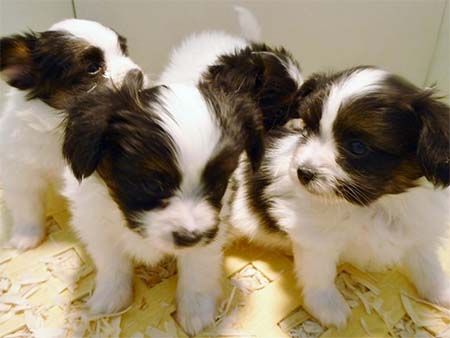
CHARLOT CLONES AT 11 WEEKS OLD.
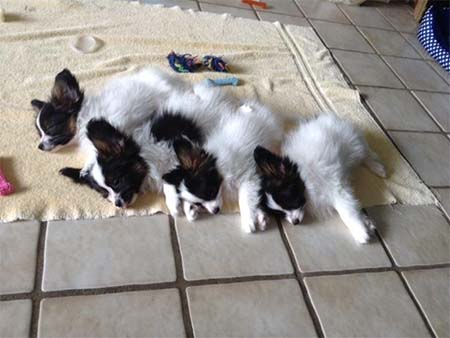
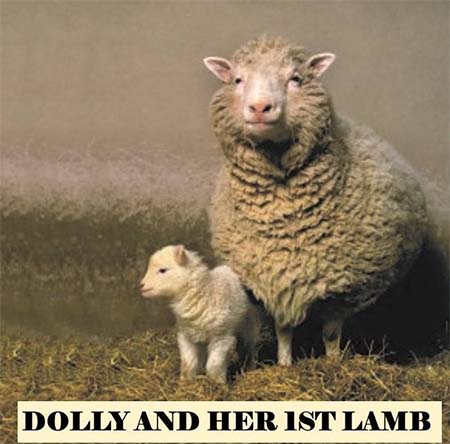 DOLLY’S 20TH ANNIVERSARY
DOLLY’S 20TH ANNIVERSARY
February 22nd. was the 20th anniversary of Dolly’s cloning announcement. Dolly the sheep was born on July 5, 1996 in Scotland. She was cloned at the Roslin Institute by Drs. Keith Campbell and Ian Wilmuth.
Dolly had three mothers (one provided the egg, another the DNA and a third carried the cloned embryo to term). She was created using the technique of somatic cell nuclear transfer. She was the first clone to be produced from an adult mammal cell.
Dolly lived her entire life at the Roslin Institute in Edinburgh. There she was bred with a Welsh Mountain ram and produced six lambs in three pregnancies.
Dolly died from lung cancer on February 14, 2003. Any connection between Dolly being a clone and her early death were dismissed. First other sheep in Dolly’s flock died of the same disease as she did. Second four other Dolly clones were produced after Dolly all of which outlived her and are still living.
The linked article provides more information:
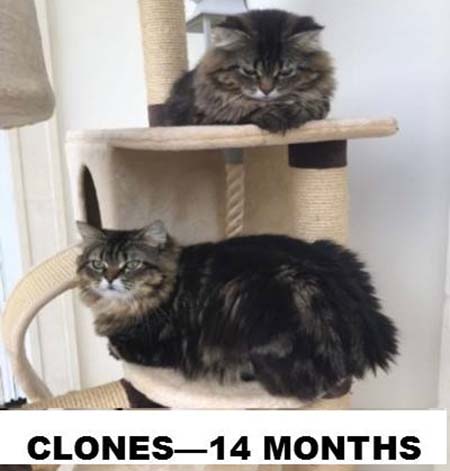 PERPETUATE’S FIRST FELINE CLONES
PERPETUATE’S FIRST FELINE CLONES
PerPETuate’s first feline clones are more than one year old. Both clones were produced from a PerPETuate cell line at ViaGen’s cloning laboratory on September 27, 2015. The European owner, who chooses to remain unidentified and not to publicize images of his original cat, is completely satisfied with the clones. Both clones are incredibly similar physically and behaviorally to the original cat and to one another.
BOB SEMEL’S CLONES
Bob Semel, a spirited Deer Chihuahua, lost his life in September 2011. Clones of Bob, produced from cells cryopreserved by PerPETuate, were born in January 2012. Bob’s clones will celebrate their 5th birthday next January.
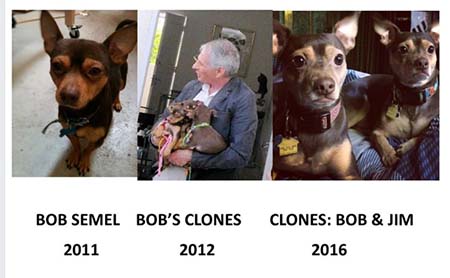
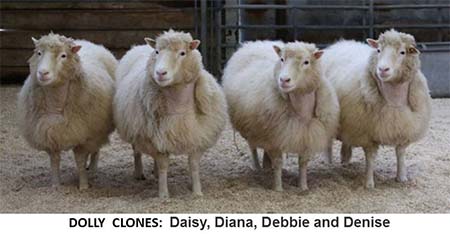 CLONED ANIMALS ARE HEALTHY AND SAFE
CLONED ANIMALS ARE HEALTHY AND SAFE
Twenty years after the birth of the world’s first clone—Dolly the Sheep—extensive research has proven that cloned animals are healthy, safe and age normally. These conclusions result from analyzing thirteen clones of Dolly during the last fourteen years. All of the clones including four, who are now eight years old, are free of the diseases that caused Dolly’s premature death when she was six years old.
Animal cloning is increasingly more reliable, better understood and accepted by animal owners and the public. New cloning applications like stem cell therapy, medical and behavioral R&D, preserving endangered species, reviving extinct ones and other unique prospects, bodes well for the future of animal cloning.
For more information, please click here.
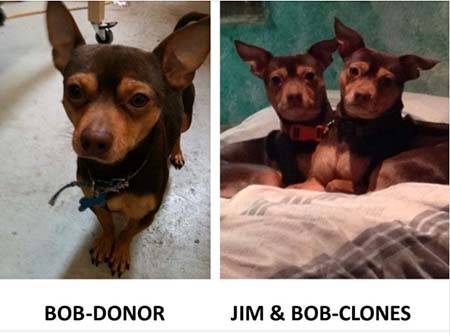 CLONES OF BOB SEMEL
CLONES OF BOB SEMEL
Bob Semel’s clones are now fully grown and nearly four years old!
PerPETuate clients and friends will remember Bob Semel and his three clones. The clones were born in South Korea in January 2012 following Bob’s tragic death in August 2011. The three clones-Bob, Jim and Tom-were some of the first dogs to be produced from a PerPETuate cell line.
From the time the clones reached their Los Angeles home in March 2012, Dr. George Semel their owner continued to be amazed with how similar the clones were to Bob and to one another in terms of temperament, personality and physically. One of the three clones-Tom-was lost in a traffic accident in when he was a year old. The other two clones-Jim and Bob-are now fully grown, healthy and full of life.
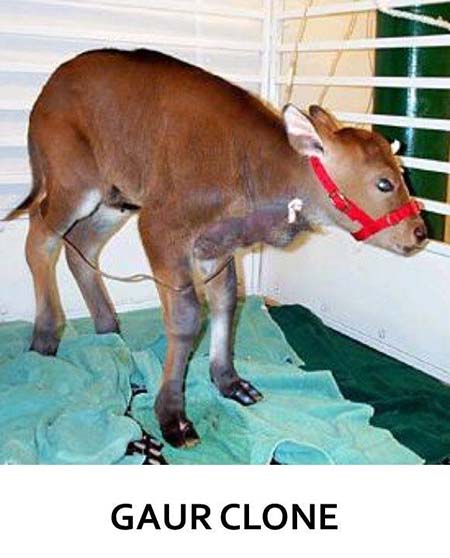 DE-EXTINCTION
DE-EXTINCTION
De-extinction is the process of creating an organism that is or resembles a member of an extinct species. De-extinction efforts have not yet succeeded in producing viable offspring of a previously extinct species, the process however has been applied successfully to endangered species such as the gaur.
PerPETuate has cryopreserved non-viable cells from many pets that could not be cultured often due to freezing. Our clients are anxiously following the advancement of de-extinction research and development with the hope that will enable them to clone their pets in the future.
View the attached video of de-extinction efforts to revive the extinct passenger pigeon: http://www.nationalgeographic.com/deextinction/
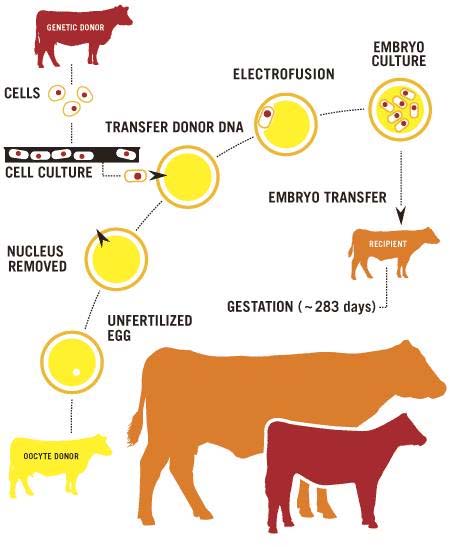 DOG CLONING CHALLENGES
DOG CLONING CHALLENGES
Dogs are the most difficult of all mammals to clone. Problems begin with fact that the canine reproductive physiology is significantly different from other species. Many procedures used in livestock cloning cannot be applied to dogs.
The limited supply of canine oocytes or immature eggs is another important challenge. Large numbers of oocytes are needed to clone dogs. Canine females tend to ovulate randomly and only twice a year. In addition they produce fewer eggs per ovulation than do other species. And mating does not trigger ovulation.
Another major challenge is that after an oocyte matures it is viable for only a few hours versus several days for other species. The entire canine cloning process from egg collection, evaluation and synchronization to somatic cell nuclear transfer and finally to transferring the cloned embryo to a surrogate mother must be completed within no more than ten hours!
Bovine Somatic Cell Nuclear Transfer
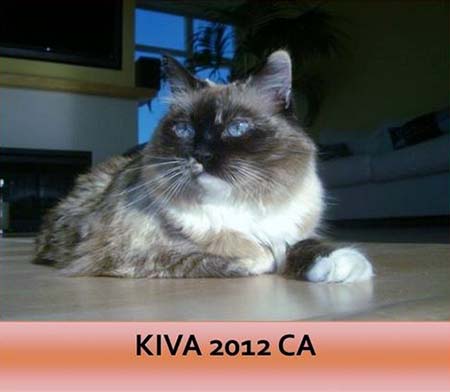 SKIN TISSUE BIOPSIES:
SKIN TISSUE BIOPSIES:
Skin from living pets is the best source of tissue for genetic culturing and preservation. PerPETuate recommends that a biopsy punch with its circular blade be used to collect two 3 to 4 mm full-thickness skin samples (each approximately size of pencil eraser). The procedure begins by administering a local or general anesthesia and then by shaving and sterilizing the biopsy site. Skin punch biopsies usually take less than 30 minutes to complete.
Biopsy Site Selection: Skin samples should not be taken from areas where bacteria tend to concentrate such as feet, rump and mouth. Possible infected skin should be avoided. The scruff of the neck is an advantageous site as it is easily assailable, clean and cannot be licked by the pet after the biopsy.
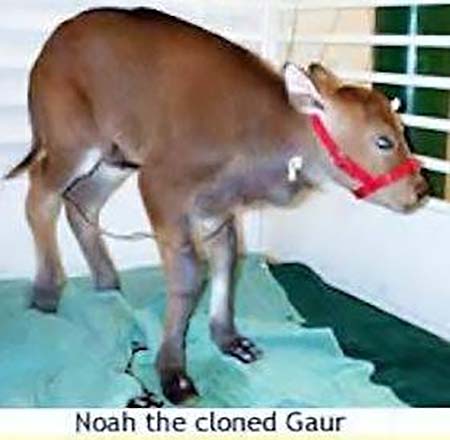 ENDANGERED AND EXTINCT SPECIES
ENDANGERED AND EXTINCT SPECIES
PerPETuate’s primary goal is to preserve genetics from exceptional pets and horses enabling these genes to be used for cloning or genetic improvement. Additionally PerPETuate encourages the use of genetic preservation and cloning for endangered breeds and species. For example in 2001 PerPETuate was associated with Advanced Cell Technology when they cloned a gaur--an endangered Asian ox.
Since PerPETuate’s founding in 1998 the use of genetic preservation, even cloning endangered animal and plant species has achieved worldwide acceptance and practice. Today scientists are pursuing the much more daunting task of reviving extinct species through cloning.
Happy Birthday Charles Darwin!
Charles Darwin revolutionized the world with his theories on evolution and inherited traits passed on from parents to offspring in the early 1800's. Now, more than two centuries later, the ideas set forth by the great grandfather of genetics has not only shaped our views on breeding plants and animals but opened our eyes and minds to the infinite possibilities of genetic research. February 12th marked the 206th anniversary of the birth of Charles Darwin and a summary of his impact on genetics through the years can be found here:
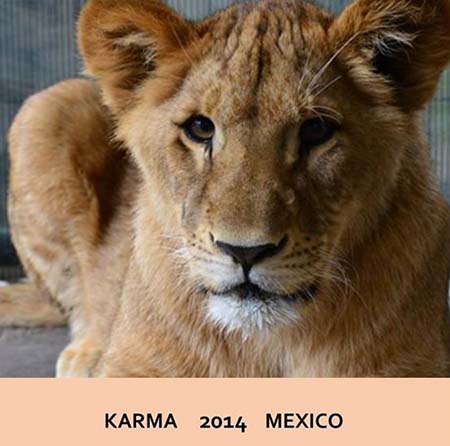 KARMA
KARMA
PerPETuate recently preserved genetics from Karma, a beautiful female African Lion. Following Karma’s untimely death The Black Jaguar-White Tiger Foundation undertook extraordinary efforts to hand carry and deliver Karma’s blood samples from Mexico City to PerPETuate’s laboratory in Worcester, Massachusetts.
The Black Jaguar-White Tiger Foundation rescues cruelly treated Big Cats from circuses, zoos and illegal breeders. In 2013 the Foundation’s founder rescued a newly born Black Panther cub about to be euthanized after her mother died during birth. Since then the Black Jaguar-White Tiger Foundation has rescued more than 30 lions, tigers and jaguars. You can learn more and support The Black Jaguar-White Tiger Foundation by visiting their website: www.blackjaguarwhitetiger.org
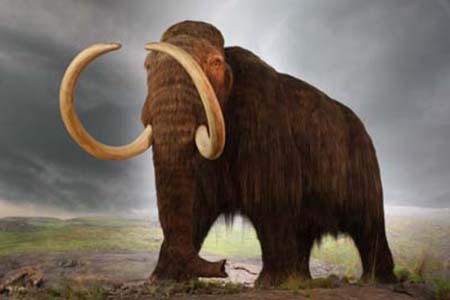 DOG AND WOOLLY MAMMOTH CLONING
DOG AND WOOLLY MAMMOTH CLONING
The Smithsonian Channel features efforts by the Sooam Foundation of South Korea’s involvement in attempts to clone an extinct Woolly Mammoth in a new video. The video offers excellent dog cloning and woolly mammoth visuals as well as raises some of the controversial issues.
You can access the link here
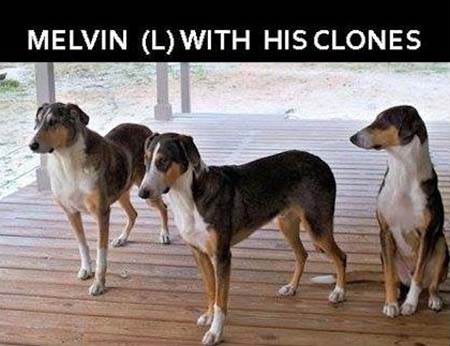 MELVIN CLONES AT 14 MONTHS
MELVIN CLONES AT 14 MONTHS
Melvin Dupont’s clones—Ken and Henry—are now 14 months old. Their owners Dr. Phillip and Paula Dupont note that while the clones are rapidly maturing, Melvin (pictured on left) is showing his age. When visitors to the Dupont Veterinary Clinic in Lafayette, Louisiana see the three dogs, they frequently comment on their remarkable similarity.
The clones’ weights have consistently been within one pound of each other and have developed like Melvin did. The major physical differences between clones are that Henry (middle) has a white stripe between his eyes and a smaller head than Ken (right).
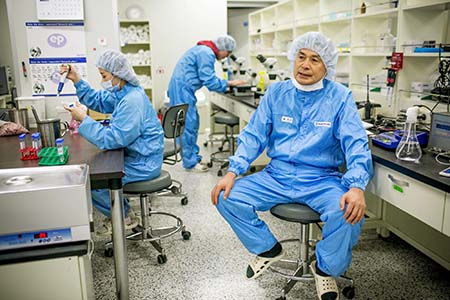 DR. HWANG WOO-SUK
DR. HWANG WOO-SUK
Dr. Hwang Woo-suk, the founder of Sooam Biotech Research Foundation, continues his struggle to regain and extend his credibility beyond dog cloning to human stem cell development. For a detailed account of Dr. Hwang’s challenges please read the following recent New York Times article.
For article click here.
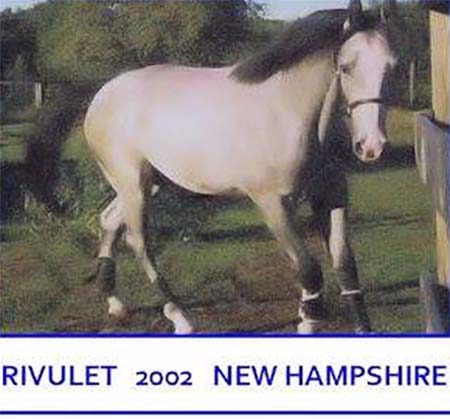 AUTHENTICATION OF EQUINE CLONES
AUTHENTICATION OF EQUINE CLONES
PerPETuate was one of the first biotechnology companies to preserve genetics from exceptional horses when we developed Rivulet’s cell line in 2000. Since Rivulet’s cell have been joined by cells from other outstanding horses. Equines are but one species of large animals whose DNA PerPETuate has cryopreserved.
In July 2013 the Federal Court in Amarillo, Texas took a major step towards legitimizing equine cloning when it ruled that professional breed associations like the American Quarter Horse Association must register cloned horses.
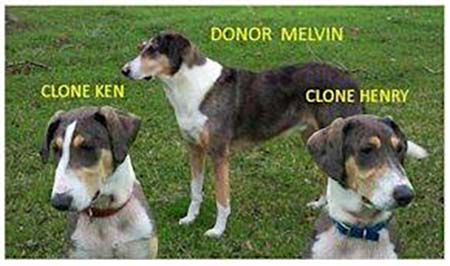 MELVIN AND HIS CLONES
MELVIN AND HIS CLONES
Melvin Dupont’s clones—Ken and Henry—are nearly six months old. Physical similarities between Melvin and his clones and between the clones are apparent in the photo below. All three have four white feet, white tail tips, black blotches in grey their coats and white collars. Interestingly the clones’ ears are miss-matched like Melvin's. Each has one semi-perky flat hound like ear and one ear that is always flopped backwards! There are slight differences such as the white streak on Ken’s face.
The owners, Dr. Phillip and Paula Dupont say they are amazed how similar in behavior the clones are to Melvin. They yawn, stretch and squeak like Melvin. And all three are smart and testy!
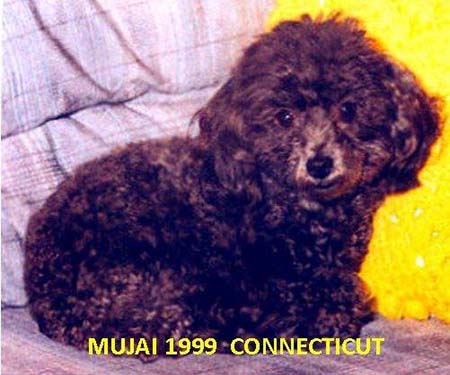 PET OWNERS: PLEASE THINK AHEAD!!
PET OWNERS: PLEASE THINK AHEAD!!
PerPETuate receives calls every day from distressed pet owners begging us to develop cell lines from their exceptional pets. Often it is too late! The pet has been dead or was frozen too long or cremated. Their next question is whether it is possible to develop a cell line from fur, nails, buccal swabs or other material. PerPETuate sadly replies: “no it is not possible.”
Dear owners of exceptional pets to clone your pet a viable cell line is required! Cell lines are produced from small tissue samples that can are collected while your pet is alive or immediately after death.
Think ahead by discussing your desire to clone your pet with your family and veterinarian then proceed with developing a viable cell line. Advise your pet owning friends to do the same. Lastly keep PerPETuate’s phone number handy so you can contact us in emergencies—508-641-7775.
Whatever you do, don’t call PerPETuate when it is too late!
GENE BANKING ENDANGERED SPECIES
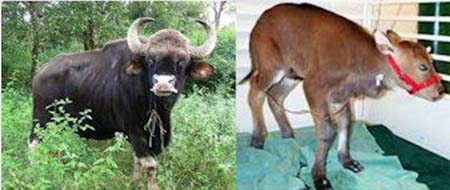
Genetic preservation and cloning are saving endangered and declining species. Cells cryopreserved from rare animals are being kept viable for generations to come. These cells can be used to replenish diminishing species by cloning. The cryopreserved genes are positioned to serve the species future bio-diversity needs.
The first endangered animal to be cloned was the gaur. The gaur or Indian bison is a large bovine that is native to South and Southeast Asia. During the past three generations gaur population has declined by more than 70% due to hunting and habitat loss.
In 2001 Advanced Cell Technology developed a cell line from a gaur and used oocytes from cows to produce the cloned embryos that were transferred to surrogate mother cow. Nine months later a healthy vigorous gaur calf was born. The experiment successfully demonstrated endangered species and cross-species cloning.
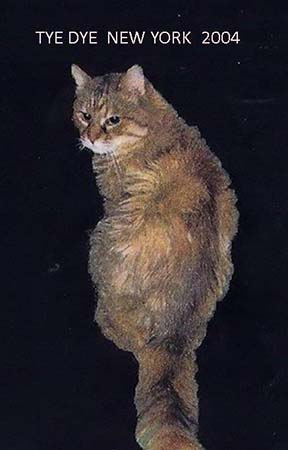 GENOTYPES
GENOTYPES
Genotypes are a unique component of PerPETuate’s genetic preservation service. A genotype is defined as the genetic makeup of a cell, an organism or an individual. Genotypes are commonly referred to as DNA signatures.
The University of California Davis Genetics Laboratory develops genotypes for PerPETuate clients. The UC Davis lab examines and reports on 17 genetic sites for felines and 24 genetic sites for canines. Two versions of genetic information called alleles are presented for each of these sites. One of the alleles is inherited from the mother, the other from the father. The entire set of allelic pairs carried by a specific animal is known as its genotype and is unique to the animal being tested. Genotypes are presented as an alphanumeric sequence.
PerPETuate’s genotypes enable pet owners to identify absolutely their pet and their pet’s cells and clones. In addition UC Davis genotypes are used for animal parentage verification, identification, forensics services, genetic diagnostics and genetic disease research for pets, livestock, primates and wildlife.
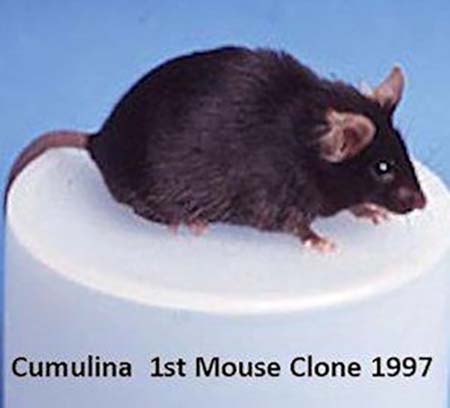 MICE CLONING DEVELOPMENT
MICE CLONING DEVELOPMENT
Mice continue to make significant cloning research and development contributions. Dr. Yamaguchi at the University of Hawaii produced the first mouse clone—Cumulina—in October 1997. Cumulina and her nine sister clones validated that Dolly the sheep who was born in 1996 was in fact a clone and proved that clones can be produced from adult animal cells.
Mice are used extensively in laboratory R&D. They are small, inexpensive, reproduce quickly and easy to maintain. Several generations of mice can be observed in a short period of time.
Dr. Teruhiko Wakayama, Dr. Yamaguchi’s protégé recently made news by cloning a mouse 25 consecutive times. In other words, he cloned one mouse, than cloned its clones and so on. The 25 consecutive generations produced 581 healthy mice all of which were fertile and lived a normal life span of about two years.
Prior to Dr. Wakayama’s success attempts to "reclone" other animals were limited to three generations and often resulted in genetic abnormalities and failures. Dr. Wakayama was able to overcome “recloning” problems with new techniques and solutions.
Dr. Wakayama’s research will enable animals that are going extinct and uniquely superior animals to be reproduced for as long as desired or needed. You can read more about Dr. Wakayama’s research here.
MELVIN AND HIS CLONE TOGETHER!
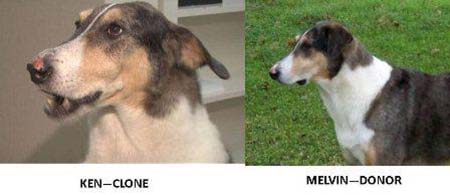
PerPETuate introduced you to Melvin’s clone on September 7. We are delighted that Melvin and his clone named Ken are now together in Louisiana! Sooam Research from Seoul, South Korea delivered Ken to his owners’ Paula and Phillip Dupont last week. This is the first time that PerPETuate has been able to show a clone together with their donor.
Check out TV video coverage here.
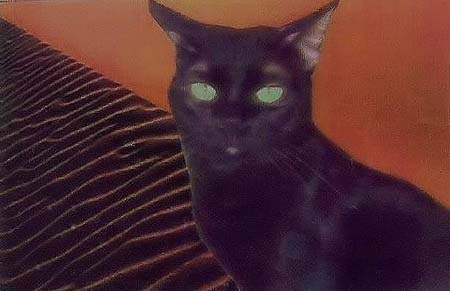 EXCEPTIONAL PET: MORPHEUS
EXCEPTIONAL PET: MORPHEUS
Morpheus is an exceptional example of a unique feline breed—Chausie. Chausies are tall, statuesque cats with long legs and large mobile tufted ears. They resemble their Jungle Cat ancestors of ancient Egypt. Chausies are good natured, loyal and intelligent.
Morpheus was a loving, gentle, striking silver-tipped melanistic Chausie. He was very muscular and had superior intelligence as evident by his opening doors with his hands!
Morpheus, who has been in the PerPETuate genetic preservation program since 2002, was the Most Loving Cat in the World!
MELVIN’S CLONE!
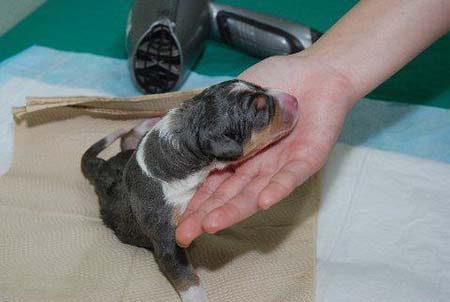
Paula and Phillip Dupont are pleased to announce the arrival of Melvin’s clone in South Korea on September 6th! See Melvin: PerPETuate’s next clone on September 4, 2012.
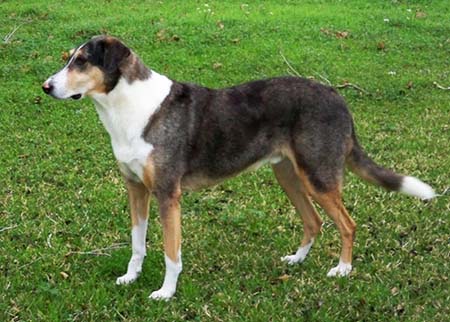 MELVIN: PerPETuate’s Next Clone
MELVIN: PerPETuate’s Next Clone
Paula and Phillip Dupont are anxiously awaiting the arrival of their clone of Melvin in September. Melvin a nine year old Catahoula-Doberman mix is also awaiting the arrival of his clone in Lafayette, Louisiana. The Duponts unlike most owners of PerPETuate clones have gone public with their plan to clone Melvin at the Sooam Institute in South Korea. PerPETuate will keep you informed.
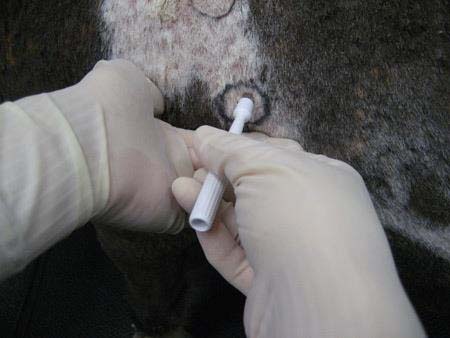 When is the best time for collecting tissue?
When is the best time for collecting tissue?
Today! Take tissue samples when your pet is healthy and strong.
Two small pieces of skin are all that is required.
DO CLONES AGE PREMATURELY?
A new PerPETuate client from West Virginia was concerned that clones don’t live as long as their donors. He noted that Dolly the sheep died at an early age. We told him that Dolly together with several other sheep in her barn died of a virus that had nothing to do with cloning. The world’s second clone, Gene the cloned bull, was born in 1997 and the last we heard is still alive in Wisconsin. Clones do not age prematurely.
Would Departed Fido Want to Leash Up Again? Ask Him.
New York Times Article
Surprisingly, it’s possible to take “I Cloned My Pet 2” seriously for almost its entire length. Right up until the moment when one pet owner consults a medium to find out her dead dog’s opinion on whether she should clone him.
The show, Monday on TLC, is a follow-up to an installment broadcast in January. Three cases occupy the hour: a Florida couple, Edgar and Nina Otto, who had their Labrador retriever cloned; a Beverly Hills cosmetic surgeon, Dr. George Semel, who wants his Chihuahua back; and a Los Angeles woman named Myra who was so fond of a basenji named Kabuki that she saved his blankets and such in hermetically sealed bags.
PerPETuate's Bob clones are on Good Morning America today!
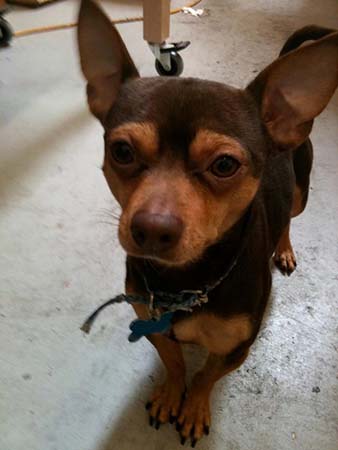
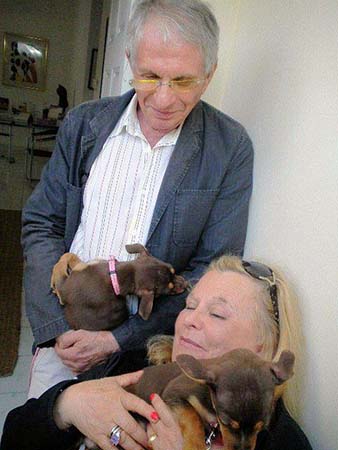 For the last two weeks, we posted an image of Dr. George Semel three clones of his exceptional dog Bob on March 23, 2012. Bob met with a tragic death when he was attacked by a large off-leash dog a few months ago. Dr. Semel seeks to right the wrong that was done when he lost his patient, good humored best friend before he reached the age of three years. Here is a great picture of Dr. George Semel when he received his clones.
For the last two weeks, we posted an image of Dr. George Semel three clones of his exceptional dog Bob on March 23, 2012. Bob met with a tragic death when he was attacked by a large off-leash dog a few months ago. Dr. Semel seeks to right the wrong that was done when he lost his patient, good humored best friend before he reached the age of three years. Here is a great picture of Dr. George Semel when he received his clones.
The Discovery Channel plans to feature Dr. Semel and Bob’s clones in its second documentary on canine cloning in May. Bob was a spirited Deer Chihuahua who teased Dr. Semel by picking his pockets and untying his shoelaces. Bob’s clones are already exhibiting much of Bob’s unique behavior!
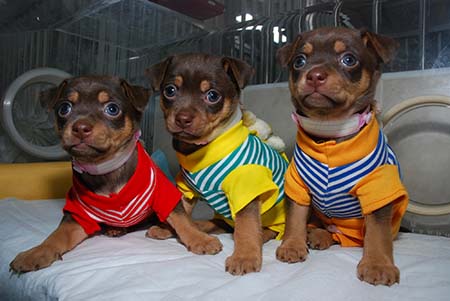 A few weeks ago, we posted an image of Dr. George Semel when he received three clones of his exceptional dog Bob on March 23, 2012. Bob met with a tragic death when he was attacked by a large off-leash dog a few months ago. Dr. Semel seeks to right the wrong that was done when he lost his patient, good humored best friend before he reached the age of three years. Here is a great picture of the three clones Dr. George Semel received when they were babies. Stay tuned next week to see what they look like when they are a little bit older.
A few weeks ago, we posted an image of Dr. George Semel when he received three clones of his exceptional dog Bob on March 23, 2012. Bob met with a tragic death when he was attacked by a large off-leash dog a few months ago. Dr. Semel seeks to right the wrong that was done when he lost his patient, good humored best friend before he reached the age of three years. Here is a great picture of the three clones Dr. George Semel received when they were babies. Stay tuned next week to see what they look like when they are a little bit older.
The Discovery Channel plans to feature Dr. Semel and Bob’s clones in its second documentary on canine cloning in May. Bob was a spirited Deer Chihuahua who teased Dr. Semel by picking his pockets and untying his shoelaces. Bob’s clones are already exhibiting much of Bob’s unique behavior!
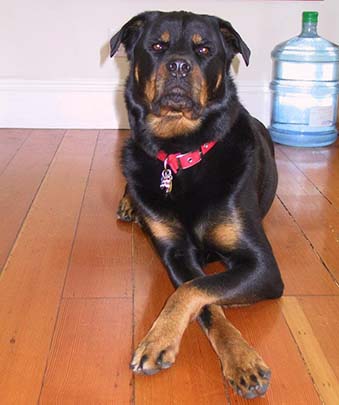 Name: Bear
Name: Bear
Location: Santa Barbara, CA
Bear was one-of-a-kind. In a world where the sight of a Rottweiler strikes fear in many hearts, Bear would instantly convince the most timid of visitors that he was a lover. He loved kids and would protect them like they were his own. Bear loved his family and his impression has been left on everyone he had met.
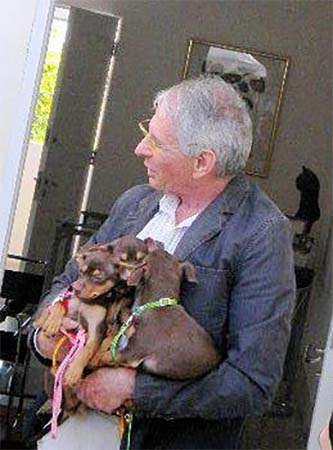 Dr. George Semel received three clones of his exceptional dog Bob on March 23, 2012. Bob met with a tragic death when he was attacked by a large off-leash dog a few months ago. Dr. Semel seeks to right the wrong that was done when he lost his patient, good humored best friend before he reached the age of three years.
Dr. George Semel received three clones of his exceptional dog Bob on March 23, 2012. Bob met with a tragic death when he was attacked by a large off-leash dog a few months ago. Dr. Semel seeks to right the wrong that was done when he lost his patient, good humored best friend before he reached the age of three years.
The Discovery Channel plans to feature Dr. Semel and Bob’s clones in its second documentary on canine cloning in May. Bob was a spirited Deer Chihuahua who teased Dr. Semel by picking his pockets and untying his shoelaces. Bob’s clones are already exhibiting much of Bob’s unique behavior!

 Scroll down to episode 640, as George Semel is interviewed about cloning his dog. TLC was on hand to film this interview for an upcoming episode of their show "I Cloned My Pet". http://ow.ly/a7Ik7
Scroll down to episode 640, as George Semel is interviewed about cloning his dog. TLC was on hand to film this interview for an upcoming episode of their show "I Cloned My Pet". http://ow.ly/a7Ik7
Phone: 508-641-7775 | Email PerPETuate

